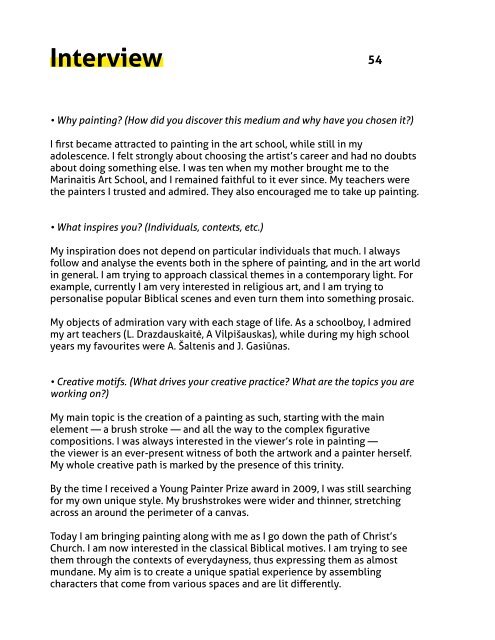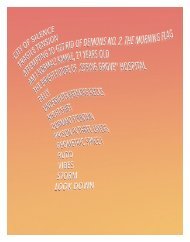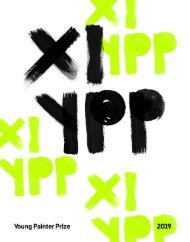X YPP Book
The main aim of the project - to discover new talent in Baltic States.
The main aim of the project - to discover new talent in Baltic States.
Create successful ePaper yourself
Turn your PDF publications into a flip-book with our unique Google optimized e-Paper software.
Interview<br />
54<br />
• Why painting? (How did you discover this medium and why have you chosen it?)<br />
I first became attracted to painting in the art school, while still in my<br />
adolescence. I felt strongly about choosing the artist’s career and had no doubts<br />
about doing something else. I was ten when my mother brought me to the<br />
Marinaitis Art School, and I remained faithful to it ever since. My teachers were<br />
the painters I trusted and admired. They also encouraged me to take up painting.<br />
• What inspires you? (Individuals, contexts, etc.)<br />
My inspiration does not depend on particular individuals that much. I always<br />
follow and analyse the events both in the sphere of painting, and in the art world<br />
in general. I am trying to approach classical themes in a contemporary light. For<br />
example, currently I am very interested in religious art, and I am trying to<br />
personalise popular Biblical scenes and even turn them into something prosaic.<br />
My objects of admiration vary with each stage of life. As a schoolboy, I admired<br />
my art teachers (L. Drazdauskaitė, A Vilpišauskas), while during my high school<br />
years my favourites were A. Šaltenis and J. Gasiūnas.<br />
• What can you tell us about your creative process? Where does your artwork start<br />
and where does it end?<br />
My creative process starts in my mind with a daily practice of playing around<br />
with the mental images. After settling on the mental imagery, I start looking for<br />
the matching visual forms by sketching, taking pictures, drawing. I always have<br />
this preparatory and very personal dance around the canvas before committing<br />
to the painting process itself. Apart from witnessing the emergence of an image, I<br />
am always searching for the new creative possibilities that arise during the<br />
process of painting. Sometimes I’m annoyed when my mind forms images<br />
quicker than they are shaped by my brush. The real images sometimes fall short<br />
of their mental originals. Sometimes the result might be very far from what I was<br />
expecting. I finish painting only when I feel satisfied with the result. When the<br />
work is done, I invite a photographer to take a picture of the painting — to me,<br />
this signifies the completion of the process.<br />
• Have you ever seriously doubted your choice to become an artist? (If so, what<br />
stopped/reassured you?)<br />
I never had any doubts regarding the path I chose. Even during the hard times I<br />
knew that painting was my way of thinking and living.<br />
• Creative motifs. (What drives your creative practice? What are the topics you are<br />
working on?)<br />
My main topic is the creation of a painting as such, starting with the main<br />
element — a brush stroke — and all the way to the complex figurative<br />
compositions. I was always interested in the viewer’s role in painting —<br />
the viewer is an ever-present witness of both the artwork and a painter herself.<br />
My whole creative path is marked by the presence of this trinity.<br />
By the time I received a Young Painter Prize award in 2009, I was still searching<br />
for my own unique style. My brushstrokes were wider and thinner, stretching<br />
across an around the perimeter of a canvas.<br />
Today I am bringing painting along with me as I go down the path of Christ’s<br />
Church. I am now interested in the classical Biblical motives. I am trying to see<br />
them through the contexts of everydayness, thus expressing them as almost<br />
mundane. My aim is to create a unique spatial experience by assembling<br />
characters that come from various spaces and are lit differently.<br />
• Do you find the Baltic art scene interesting? (What is your opinion about<br />
Lithuanian, Latvian and Estonian art? How would you describe their differences?)<br />
I am interested in everything that is happening in the Baltic region. I am<br />
keeping in touch with both Latvian and Estonian artists, however I personally<br />
prefer Estonian art better. I admire artists such as Kaido Ole, Marko Maetam, and<br />
Merike Estna. However I avoid making judgements about art based on the<br />
criterion of regionality, I rather use my personal aesthetic preferences.<br />
• How did the Young Painter Award influence your artist’s career?<br />
I was awarded in 2009, when I was still a student in the Vilnius Academy of Arts.<br />
To me it felt like a tremendously important recognition of what I do. It served<br />
as a great impetus to keep up with the work of painting. I think these kinds of<br />
acknowledgements are very important to artists, especially at the beginning of<br />
their careers. I am sure young painters are appreciating the growing importance<br />
of this Award. I think it has greatly contributed to my self-confidence as an artist.





